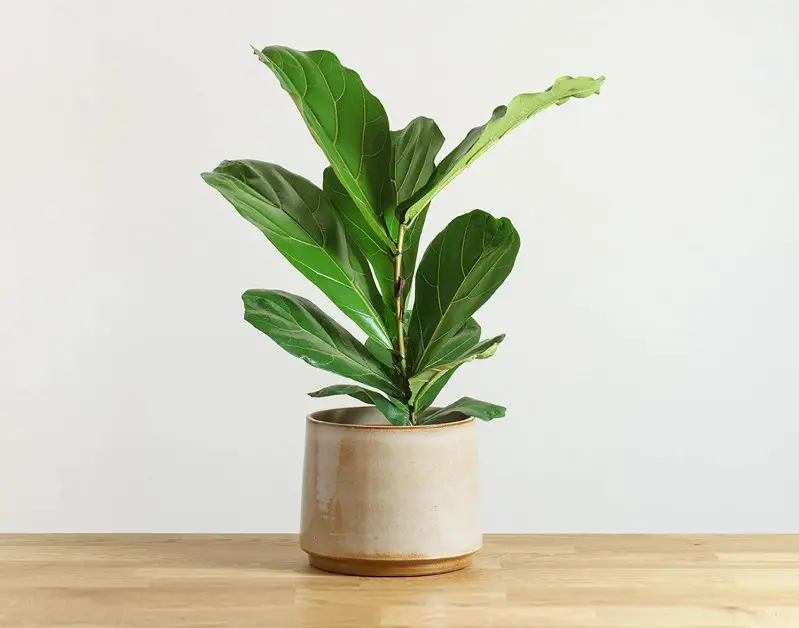Ficus Lyrata, commonly known as the fiddle leaf fig, has taken the world of indoor plants by storm. Its large, glossy leaves and tree-like form make it a favorite among plant lovers, despite its reputation for being somewhat finicky. With the right care, however, even novice gardeners can enjoy the beauty of this striking plant.
This guide provides a comprehensive overview of how to care for and grow Ficus Lyrata to ensure it thrives in your home.
Overview of Ficus Lyrata
Common Name: Fiddle leaf fig, banjo fig
Botanical Name: Ficus lyrata
Family: Moraceae
Plant Type: Broadleaf evergreen
Mature Size: Up to 50 feet outdoors, 10 feet indoors
Sun Exposure: Bright, indirect light
Soil Type: Loamy, well-draining
Soil pH: Slightly acidic to neutral (6-7)
Hardiness Zones: USDA zones 10-12
Native Area: Tropical western Africa
Toxicity: Toxic to humans and pets
Now, let’s dive into the most detailed care instructions to help your fiddle leaf fig flourish in your home.
Ficus Lyrata Care: Essential Tips

Light Requirements for Ficus Lyrata
One of the most important aspects of Ficus Lyrata care is providing the right amount of light. These plants thrive in bright, indirect light, which mimics their natural environment under the tropical canopies of western Africa. Ideally, your fiddle leaf fig should receive about six hours of indirect sunlight daily. Morning sunlight from an east-facing window is perfect, while direct afternoon sun, especially from west-facing windows, can scorch the leaves.
If your plant doesn’t get enough light, it may develop slow growth and brown spots on its lower leaves. In this case, consider moving it closer to a light source or supplementing natural light with a grow light.
The Best Soil for Ficus Lyrata
Fiddle leaf figs prefer a well-draining, loamy soil mix. A peat-based mix combined with perlite or sand works well for indoor plants. You can also use a 50/50 mixture of cactus soil and houseplant potting soil, which helps maintain the right balance of moisture and drainage. The key is to ensure the soil allows excess water to drain away easily, as standing water can lead to root rot.
How Often to Water Ficus Lyrata
Watering a Ficus Lyrata requires balance. These plants enjoy moderately moist soil, but overwatering can be detrimental. A good rule of thumb is to water your fiddle leaf fig when the top inch of soil feels dry to the touch. Always check the moisture level before watering to avoid drowning the roots.
Water thoroughly, allowing the excess to drain from the bottom. It’s also a good idea to flush the soil once a month to prevent a buildup of salts from water and fertilizer. Signs of under-watering include wilting and dry, crispy leaves, while overwatering can cause yellowing leaves and root rot.
Temperature and Humidity Needs for Ficus Lyrata
Fiddle leaf figs are fairly tolerant of standard household conditions, but they thrive best in warm environments with steady temperatures between 60°F and 85°F (15°C to 29°C). Sudden temperature fluctuations can stress the plant, leading to issues such as leaf drop.
Humidity is another crucial factor. These tropical plants prefer higher humidity levels, ideally between 30% and 65%. If your indoor air is too dry, especially during winter, consider using a humidifier or placing a tray of water near the plant to maintain moisture. Misting the leaves can also help, but be cautious not to create overly damp conditions that can encourage fungal issues.
Fertilizing Ficus Lyrata
Like most indoor plants, fiddle leaf figs benefit from regular feeding during their growing season, typically from spring to early fall. Use a high-nitrogen fertilizer with an NPK ratio of 16-5-11, which supports healthy leaf growth. Water-soluble fertilizers are a good option, and you should apply them about once a month during the active growing phase.
Be careful not to over-fertilize, as this can lead to nutrient buildup in the soil, causing root burn. Always follow the package instructions and consider reducing feeding frequency in the winter when the plant’s growth slows.
Pruning and Shaping Ficus Lyrata
Pruning is essential to maintain the size and shape of your fiddle leaf fig. The best time to prune is during the growing season (late spring or summer). To encourage branching, trim the main stem when the plant reaches about 5 feet in height. Make the cut just above a leaf node to stimulate new growth.
Additionally, you can remove any dead or damaged leaves throughout the year. If your plant develops brown edges, trim them following the natural shape of the leaf. Always use clean, sharp pruning shears to avoid damaging the plant, and wear gloves, as the sap can irritate the skin.
Propagating Ficus Lyrata
Propagating fiddle leaf fig is fairly easy and can be done either in water or soil. Follow these steps to propagate your plant successfully:
- Take a cutting: Choose a healthy branch with at least three leaf nodes. Cut it at a 45-degree angle just above a node.
- Prepare the cutting: Remove the lower leaves, leaving one or two at the top.
- Root in water: Place the cutting in a glass of room temperature water, ensuring the nodes are submerged. Keep it in bright, indirect light and change the water weekly. Roots should form in 2-3 weeks.
- Transplant: Once roots are about 1-2 inches long, transplant the cutting into well-draining potting soil.
For soil propagation, dip the cutting in rooting hormone and plant it directly into a pot with fresh soil. Keep the soil moist and cover the pot with a plastic bag to retain humidity until roots develop.
Common Pests and Diseases
Fiddle leaf figs are relatively hardy, but like most indoor plants, they can be prone to a few pests and diseases. Spider mites, scale insects, and mealybugs are the most common pests. You can usually spot them by the webbing or small dots on the leaves. Neem oil or horticultural oil works well to eliminate these pests.
For fungal diseases, overwatering and poor drainage are often the culprits. Ensure your plant has good air circulation and avoid letting it sit in water. Brown spots on leaves are often an indication of root rot, while yellowing leaves might suggest a bacterial infection. In these cases, remove the affected leaves and consider repotting the plant in fresh soil.
Troubleshooting Common Ficus Lyrata Problems
Brown Spots on Leaves
Brown spots are one of the most common issues with Ficus Lyrata. If you notice dark brown spots, particularly near the base of the leaves, your plant may be suffering from root rot due to overwatering. Trim away any affected roots and repot the plant in fresh, dry soil.
If the spots are lighter and appear on the top of the leaves, your plant may be experiencing leaf scorch from too much direct sunlight. Move the plant to a spot with more filtered light to prevent further damage.
Yellowing Leaves
Yellowing leaves can be a sign of several issues, including bacterial infections, nutrient deficiencies, or overwatering. Check the soil moisture and your fertilizing routine. If the problem persists, try removing affected leaves and repotting the plant.
Dropping Leaves
Sudden leaf drop often occurs due to environmental stress, such as changes in light, temperature, or humidity. Ensure your fiddle leaf fig is in a stable environment with consistent care. If your plant is dropping leaves but otherwise looks healthy, it may simply be adjusting to a new location.
Conclusion
With proper care, the Ficus Lyrata can be a stunning and rewarding addition to any home. Its large, glossy leaves bring a sense of tropical elegance, and its upright growth habit makes it a perfect statement plant. By providing the right light, water, temperature, and care, your fiddle leaf fig will thrive and grow into a beautiful, indoor tree that will elevate any living space.
Take the time to monitor its needs, and don’t hesitate to prune or propagate as needed. With patience and attention, even beginners can master the art of Ficus Lyrata care.






